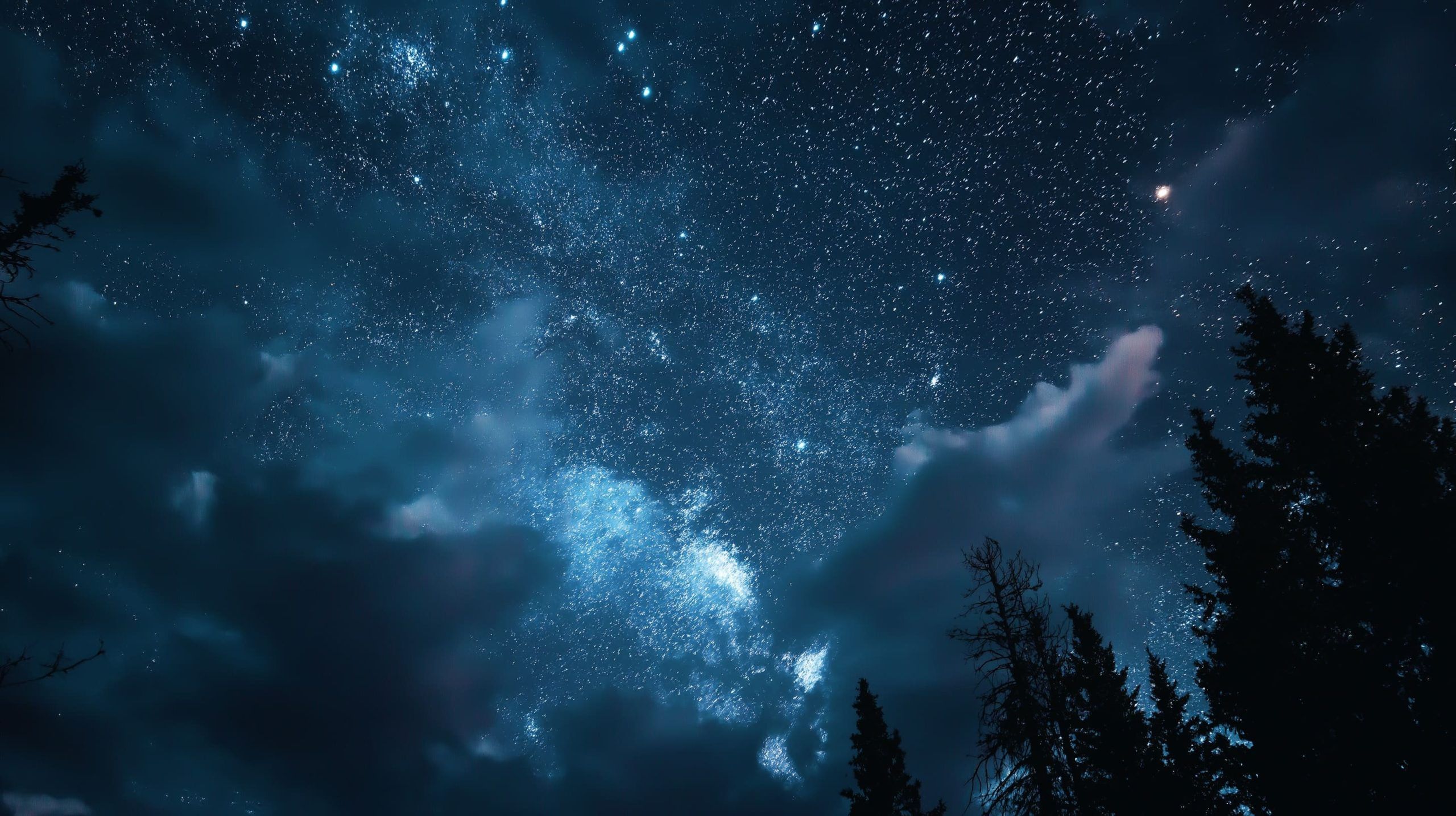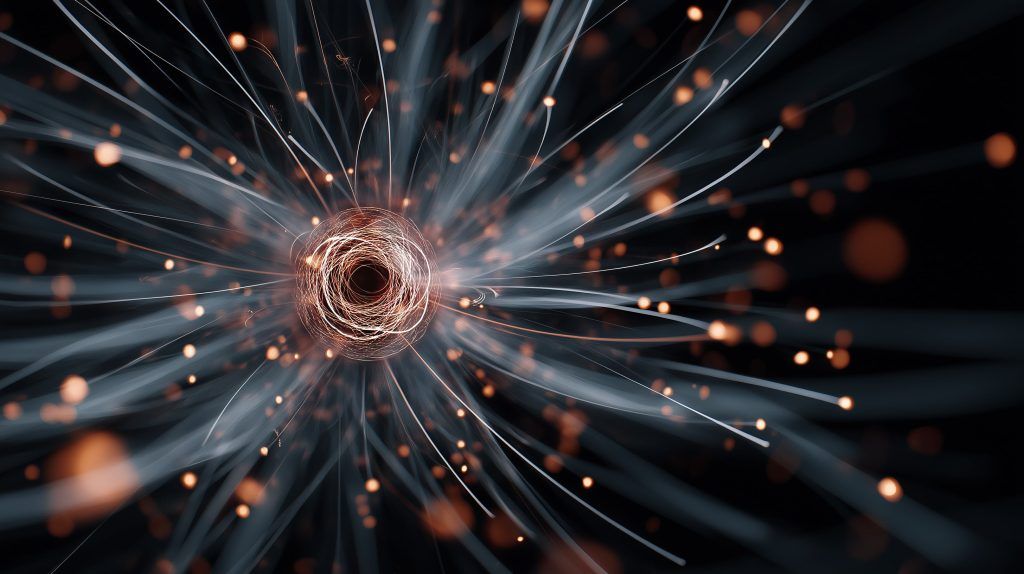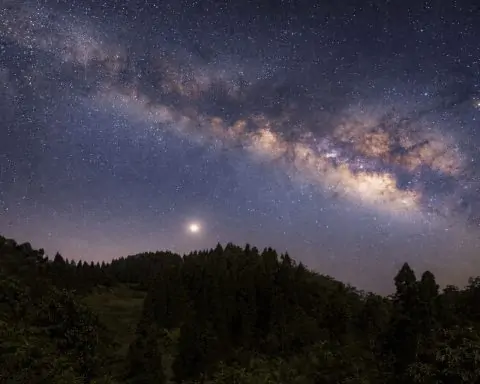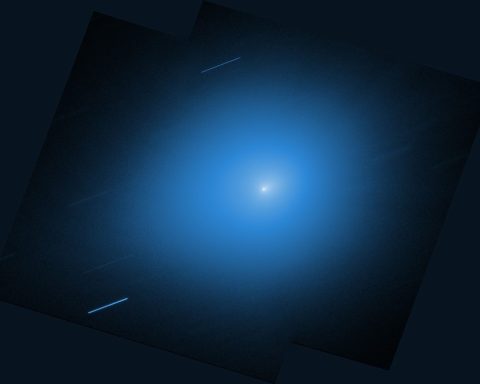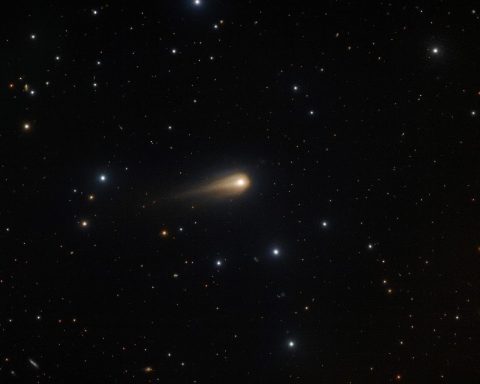- During the Aug 2–3 predawn hours under dark skies at mid-northern latitudes, observers could see about 20 meteors per hour as the Perseids rise.
- The Moon is in first-quarter and will set in the early morning, washing out fainter Perseids and potentially reducing observed rates by about 75% near the maximum.
- Delta Aquariids are tapering after their July 30 peak and may contribute only a few meteors per hour on Aug 2–3, while Alpha Capricornids are sparse but known for bright fireballs.
- Saturn and Neptune are in conjunction on Aug 6, and during Aug 2–3 they rise together; Saturn is around magnitude 0.8 and Neptune around magnitude 7.8, viewable in the same low-power field with a telescope.
- Mars remains visible in the western sky after sunset, at about magnitude +1.6, in southwestern Virgo near Beta Virginis on Aug 2.
- Mercury is not yet visible on Aug 2–3, but it will re-emerge in mid-August for its best morning apparition toward the end of the month.
- Venus and Jupiter form a dawn pairing in the eastern sky on Aug 2–3, separated by about 9 degrees with magnitudes of about -4.0 for Venus and -1.9 for Jupiter, and they will approach a close conjunction around Aug 11–12.
- Titan will cast a shadow on Saturn during a transit from about 6:25 to 11:04 UTC on Aug 3, observable from North America with a moderate-to-large telescope, and Enceladus and Tethys also cross Saturn that morning.
- The Moon will pair with Antares on Aug 2–3, with Antares being a bright red-orange star around 1st magnitude, and an occultation by the Moon is possible in parts of Polynesia, New Zealand, southern South America, and Antarctica around Aug 4 UTC.
- Space weather looks quiet for Aug 2–3, with NOAA forecasting no G1 storms and a maximum Kp of 2–3, so auroras will likely be limited to polar regions, and the Moon will be about 70% illuminated that weekend.
The first weekend of August 2025 is packed with celestial sights. From meteors streaking through warm summer nights to bright planets converging at dawn, there’s plenty for skywatchers to enjoy on August 2–3. Below, we break down all the must-see skywatch alerts – and bust a few myths – for this weekend, including where and when to look (and whether events are visible worldwide or only in certain regions).
Meteor Showers Light Up Early August
Perseid meteors are on the rise. The famous Perseid meteor shower is ramping up now, though it won’t reach its peak until August 12–13. Even in early August, we’ve “entered the Perseid meteor stream,” meaning you might catch some Perseids anytime now [1]. In fact, meteor activity kicks into high gear in August – not only because of the Perseids, but also because random “sporadic” meteors are near their annual high, roughly double their springtime rates [2]. If you watch in the wee hours between midnight and dawn this weekend (after the Moon sets), you could see on the order of 20 meteors per hour under dark-sky conditions at mid-northern latitudes [3] (a bit fewer in the Southern Hemisphere). This includes a mix of Perseids and other background meteors. The Moon is at first quarter phase and waxing, so it will set in the early morning hours, leaving a couple of hours of good dark-sky viewing before dawn on August 2–3 [4] – perfect timing to spot some shooting stars.
Why so few? Normally the Perseids can produce 60–100 meteors per hour at their peak, but this year a bright Moon will wash out many of the fainter meteors, potentially reducing observed rates by 75% [5] around the peak night. Instead of 100 per hour, observers might only count on the order of 10–20 meteors per hour at best during the maximum [6]. The American Meteor Society notes that in 2025, the waning gibbous Moon will “severely compromise” the Perseids at maximum, as only the brighter fireballs will shine through the moonlight [7]. The good news is that many Perseids are bright and often leave colorful streaks. So even if the meteor counts are lower, a few spectacular fireballs could still blaze across the sky – each one a piece of debris from Comet Swift–Tuttle burning up in Earth’s atmosphere.
Other active showers: The Perseids steal the show, but they overlap with a couple of minor meteor showers also active in late July and early August. The Southern Delta Aquariids, which peaked around July 30, are now tapering off; at their best they produce a steady ~10–20 meteors per hour [8], but on August 2–3 they’ll likely contribute just a few meteors per hour (mostly faint ones) in the southern sky. Another minor shower, the Alpha Capricornids (peaked around July 29–30), is sparse in number but famous for fireballs. Capricornid meteors are few, but when they do appear they tend to be slow-moving, bright, and often yellowish. You might spot an occasional Capricornid fireball in the first week of August [9] – a nice surprise for vigilant observers. In short, don’t be surprised if a random meteor or two shows up even before Perseid rates really climb; summer nights are rich with meteors from multiple sources. And if 2025’s display is a bit muted, take heart: next year (2026) the Perseids peak under a new moon, so a truly stellar show is on the horizon [10]!
Visibility: The Perseids are best viewed from the Northern Hemisphere, since the shower’s radiant (in Perseus) climbs higher in northern skies. Southern Hemisphere observers will still catch some Perseids, but the rates are lower (the radiant stays nearer the horizon) [11] [12]. The Delta Aquariids, by contrast, are well seen from southern tropical latitudes (their radiant in Aquarius climbs higher in the Southern Hemisphere) [13]. No matter where you are, find the darkest sky possible, face away from the Moon, and give your eyes time to adjust. Peak meteor activity is usually in the predawn hours, when the side of Earth you’re on is plowing headfirst into the meteor streams.
Planets Aligning from Midnight to Dawn
A parade of planets is underway. Virtually every major planet is on display at some point during the night. Mars is still hanging on in the evening sky at dusk – look low in the west after sunset. The Red Planet is quite faint now (about magnitude +1.6) and sets soon after the sky gets fully dark [14]. On August 2, Mars was sitting in southwestern Virgo, near the 4th-magnitude star Beta Virginis [15]. It’s a tough catch in the twilight glow, but it’s there for persistent observers. Mercury, on the other hand, is not yet visible, as it’s lost in the Sun’s glare; it will re-emerge in mid-August, making its best morning apparition of the year around the end of the month [16].
Saturn takes center stage late at night. The ringed planet rises by around 10:30 p.m. local time in early August [17], coming up in the east as the evening progresses. By midnight or later, Saturn is shining well above the horizon in the constellation Pisces (not far from the asterism of the “Circlet”). At magnitude ~0.8 [18], Saturn is the brightest object in that part of the sky (aside from the Moon). This month Saturn is involved in a unique celestial meetup of its own: it is drawing very close to the distant planet Neptune. In fact, Saturn and Neptune are undergoing a conjunction – their second of three close passes – on August 6 [19] [20]. For most of us Neptune’s invisibly faint (magnitude ~7.8), but through a telescope both planets can appear in the same low-power field of view around the conjunction date [21]. If you have a large backyard telescope, you might try to spot Neptune as a tiny blue-gray speck just a fraction of a degree from Saturn in early August. (They rise together and track across the sky all night.) This Saturn–Neptune pairing isn’t something you can see with the naked eye, but it’s a rare treat for telescopic observers – a preview of the exact Saturn-Neptune alignment on Aug. 6 and again next February [22].
Jupiter and Venus: a dazzling dawn duo. The real eye-catcher for everyone – no telescope required – comes in the pre-dawn morning hours of August 2–3. Brilliant Venus and bright Jupiter are shining together in the east before sunrise, drawing closer by the day. By this weekend, the two brightest planets in the sky are already only about 9° apart (roughly the width of your fist at arm’s length) and easily visible side-by-side in the early dawn [23]. If you have a clear view toward the east-northeast about 60–90 minutes before your local sunrise, you’ll see Venus (magnitude –4.0, extremely bright) and Jupiter (about –1.9, a bit dimmer but still very bright) rising in tandem. They almost look like a “double beacon” or pair of celestial headlights low on the horizon [24]. Each morning they creep nearer: NASA notes that the two planets “appear to graze each other” in mid-August, reaching a close conjunction on August 11–12 when they’ll be just about a degree apart in the sky [25] [26]. (That’s so close you could hide both planets behind your outstretched pinky finger [27]!) Don’t miss this lovely sight if you’re an early riser – it’s one of the highlight events of the month. In fact, some astronomy enthusiasts jokingly warn that such an ultra-close pairing of Venus and Jupiter might even fool casual observers into reporting “twin UFOs” hovering in the dawn! [28]
Visibility: The Venus–Jupiter conjunction is happening in the eastern morning sky, and it will be visible around the world wherever the pre-dawn sky is clear. Observers at mid-northern latitudes will see Venus and Jupiter low but discernible above the east-northeast horizon before sunrise (look about 45° to the left of where the Sun will rise) [29]. In the Southern Hemisphere, the geometry is similar – the planets will be in the east (more east-southeast for southerners) before dawn. The main challenge is their low altitude: they don’t climb very high before the twilight grows too bright. So try to find an unobstructed horizon and start looking while the sky is still fairly dark (around 4:00–5:00 a.m. local time, depending on your latitude). Binoculars can help you pick them out of the twilight. On August 2–3, the separation is a comfortable several degrees, but as they draw nearer by Aug. 11–12, Venus and Jupiter will be extra striking – almost right on top of each other. (They won’t be this close and well-placed again for some years, so it’s truly a special sight.) Mark your calendar for Aug. 12, but enjoy the “approach” show now!
Saturn’s moons on display – Titan’s shadow transit (Aug 2–3). While you’re admiring Saturn late at night, know that something subtle but very cool is happening with Saturn’s largest moon, Titan. Approximately overnight from August 2 into August 3, Titan will cast its tiny black shadow onto Saturn’s cloud tops – essentially a mini eclipse on Saturn. This phenomenon, called a shadow transit, is observable with a moderate to large telescope (you’d see a small dark dot moving across Saturn’s disk). The event runs roughly from 6:25 to 11:04 UTC on Aug. 3 [30], which translates to 2:25–7:04 a.m. EDT or 11:25 p.m.–4:04 a.m. PDT. In other words, it spans the late-night hours of Saturday night for North America. Where is it visible? Saturn is up all night in August, so North American observers are well placed – Saturn will be high in the sky in the early-morning hours, offering a steady view [31]. Europe, however, will be in daylight during much of the transit (morning of Aug. 3), so Europeans won’t catch this one. During the transit, Titan itself (a pale orange dot) will creep in front of Saturn, and slightly offset from it you’ll see Titan’s shadow – a crisp black pinprick – sliding across Saturn’s face [32]. It’s a fascinating sight if you have the equipment. In fact, Saturn is beginning a new “Titan shadow transit season” – Titan will cross and cast shadows every 16 days for the next few months [33]. Fun fact: Sky & Telescope notes that every 15 years our viewing geometry aligns to let us see Titan transit; the current series will continue through October [34]. If you miss this one, there will be more chances into the fall (and again 15 years from now!). Additionally, two of Saturn’s smaller moons – Enceladus and Tethys – also happen to cross Saturn on the morning of Aug. 3 (UTC) around a similar time [35]. They’re much harder to spot, but it means Saturn is a busy place that night. All in all, August 2–3 offers a smorgasbord for planetary observers: from naked-eye planet pairings to telescopic moon events.
The Moon Meets Antares at Dusk
A lunar rendezvous with a red supergiant. As darkness falls on August 2 and 3, be sure to look south (or toward the south-southwest) to spot a lovely conjunction of the Moon and the star Antares. Antares is the brightest star in the constellation Scorpius, known for its vivid reddish-orange hue – it’s often called the “Heart of the Scorpion.” On Saturday Aug. 2, the waxing gibbous Moon will be positioned just a few degrees away from Antares [36]. By the next night, Sunday Aug. 3, the Moon will pair up even closer with Antares – only about 1° apart (that’s two Moon-diameters) – making for a striking visual close encounter [37]. The star and the Moon will rise together in the late afternoon/early evening and be visible through the first part of the night. Many skywatchers will notice this brilliant “double” in the sky – the Moon’s neutral white glow right next to a flickering colored star.
Color contrast: If you have a clear view, see if you can discern Antares’s fiery color next to the Moon. Antares is a red supergiant star (hundreds of times bigger than our Sun) and shines with a distinct orange-red tint. Sometimes the Moon’s proximity can actually enhance the star’s perceived color contrast. “The neutral gray of the lunar surface always seems to enhance the color of whatever star or planet the Moon is near,” notes observer Gary Seronik [38]. Many people find Antares looks like a “ruby” adjacent to the Moon’s pearl. Keep in mind, however, that the Moon is very bright compared to Antares (which, while bright for a star, is about 1st magnitude and 1.000 times fainter than the Moon!). The star might be a bit difficult to spot right against the Moon’s glare. Pro tip: use a trick from EarthSky – position yourself so that the Moon is temporarily hidden behind a building, tree, or even a utility pole. With the Moon blocked from your eye, Antares will pop into view nearby [39]. You can also try binoculars; just be careful not to stare directly at the glaring Moon for too long.
Occultation for some regions: In most of the world, the Moon will glide past Antares without covering it. But in a few parts of the globe, geometry aligns perfectly and the Moon will occult Antares – meaning Antares will disappear behind the Moon for a short period. This happens in the predawn hours of August 4 UTC (late Aug. 3 local date, depending on time zone) and will be visible from parts of Polynesia, New Zealand, southern South America, and Antarctica [40]. For example, observers in New Zealand and the Cook Islands are among those who will see Antares blink out around 2:00 UTC Aug. 4 (give or take, depending on location) as the Moon’s dark edge slides over it [41]. If you’re in one of these locales, you can check an occultation timing chart for the exact schedule [42]. It’s a neat event to witness with a small telescope or binoculars. Elsewhere (e.g. North America, Europe, most of Asia and Africa), the Moon–Antares pairing is just a close approach with no eclipse – but still a beautiful sight. The Moon and Antares will be highest in the sky during early evening and then move toward the horizon. By midnight they’ll be relatively low, setting shortly thereafter [43] (from mid-northern latitudes). So plan to observe them in the first half of the night on Aug. 2 and 3.
Visibility: The Moon is obviously visible everywhere (weather permitting), and Antares is visible from both hemispheres (it’s a southern sky star, but it comes fairly far north – about 26° South declination). Northern Hemisphere mid-latitude observers (e.g. Europe, USA) will see Antares not far above the southern horizon at dusk – the Moon will be near it. Southern Hemisphere observers (e.g. Australia, southern Africa, South America) will see Antares and the Moon higher overhead in the evening. The closest pairing on Aug. 3 is global, but the occultation is limited to the regions mentioned (Polynesia, NZ, S. America south of about 30°S, etc.) [44]. If you’re outside those areas, just enjoy the near miss!
Auroras and Space Weather Outlook
Northern Lights, anyone? The aurora borealis made some headlines at the very start of August – on Friday, Aug. 1, a minor geomagnetic disturbance gave skywatchers in several northern U.S. states and Canada a chance to see the Northern Lights. NOAA’s Space Weather Prediction Center had forecast a period of Kp 3 geomagnetic activity for that night, which indeed materialized as a gentle auroral display visible in dark skies at high latitudes [45] [46]. (Kp 3 on the 0–9 index is below official storm level, but still enough to push auroras farther from the poles than usual. NOAA noted that a Kp 3 aurora can be “quite pleasing to look at” under perfect conditions [47] – and it was!) Some lucky observers as far south as the northern continental US (e.g. Minnesota, Montana, Wisconsin) caught faint red and green glows on the horizon that night. The auroras were aided by the fact that the Moon was only about half illuminated then [48], meaning its light didn’t interfere much with the dim auroral curtains.
For the weekend of Aug. 2–3, the auroral outlook is quieter. According to NOAA’s 3-day space weather forecast, no G1-class (Minor) or stronger geomagnetic storms are expected on August 2 or 3 [49]. The maximum Kp index is predicted to remain around 2 to 3 at most [50] – in other words, some unsettled geomagnetic activity but nothing likely to produce widespread auroras. Barring an unexpected solar eruption, the Earth’s magnetic field should stay relatively calm. This means that the Northern Lights will probably be limited to their usual polar habitats – high-latitude regions like far northern Canada, Alaska, Iceland, Scandinavia, and maybe northern Scotland. If you live in those areas, it’s always worth a quick look at the north horizon on any clear, dark night just in case a weak aurora is shimmering. But for the majority of us farther south, the skies will not be lighting up with auroras this weekend.
It’s worth noting that space weather can surprise us. A sudden solar flare or coronal mass ejection could alter the forecast if it hits Earth – but none are anticipated at the moment. As of Aug. 1, the Sun has been relatively moderate in activity (no major flares in the past few days). Keep an eye on aurora alerts if you’re keen, but otherwise, enjoy the other celestial sights without expecting a green auroral glow. And if you are in a northern locale, dark adapted eyes and a moonless hour (late at night) will give you the best chance to spot any faint auroral band.
Visibility: Auroras (if they occur) will be regional. During the Aug 1 geomagnetic uptick, auroras were visible in the northernmost United States (e.g. parts of Washington, North Dakota, etc.) and of course Canada and Alaska [51] [52]. This weekend, with lower activity expected, auroras would likely only be visible in polar regions (far Northern Hemisphere, or far south if there were activity in the Southern Hemisphere – the aurora australis around Antarctica). In short, unless you live above roughly 55°–60° North, you’re unlikely to see auroras on Aug. 2–3 under the predicted conditions. Those at extreme northern latitudes might see a diffuse glow low on the horizon if anything at all.
(One silver lining: the Moon will be roughly 70% illuminated this weekend – not as bright as a full moon – so if an aurora does occur, the moonlight won’t overpower it completely [53]. During strong auroras, the Northern Lights can be visible even with a bright Moon or in light-polluted areas, but for weak auroras you want dark skies.)
ISS and Satellite Flyovers
Not all the “stars” in the night sky are natural – humanity has put plenty of objects up there too. Satellites gliding overhead can create brief but exciting skywatching moments. The most impressive is the International Space Station (ISS), which is easily visible with the naked eye when it passes overhead. In fact, the ISS typically shines as the brightest object in the night sky aside from the Moon [54]. It appears as a steady, fast-moving point of white light, taking a few minutes to cross the sky. You don’t need any special equipment to spot it – even in cities the ISS can be bright enough to see, because its football-field-sized structure reflects a lot of sunlight [55].
When and where to see the ISS: The ISS orbits Earth about 16 times per day and its path shifts, so it’s not visible every night at a given location. It flies at about 51.6° inclination, meaning it passes over regions between 51.6°N and 51.6°S latitude (about 90% of Earth’s population lives within this band) [56]. The station is only visible when sunlight hits it while your sky is dark – usually within a couple hours after sunset or before sunrise [57]. That’s when you’re in night, but the ISS 400 km above is still catching sun. These viewing windows come and go in cycles. In early August 2025, many locations in the mid-Northern Hemisphere (like Europe and the northern U.S.) are getting evening passes of the ISS shortly after dusk, while some lower latitudes might see pre-dawn passes. For example, around this weekend the ISS is making a series of visible passes in the evening sky over North America (check exact cities for times). To find out if and when the ISS will be visible for you, use NASA’s “Spot the Station” tool or a smartphone app – you enter your location and it will give you the next flyover times, including what direction the ISS will appear and how high it will get [58]. When the time comes, simply go outside and look in the given direction; the ISS will look like a bright star moving steadily (not twinkling, not flashing like an airplane). A typical pass lasts a few minutes from the time it rises above the horizon until it fades away (either disappearing into Earth’s shadow or setting). During a good, high-altitude pass, the ISS can outshine even Jupiter and Venus, reaching magnitude –3 or brighter. It’s quite a sight to think human crew members are aboard that fast-moving “star”!
Other satellites: The night sky is crisscrossed by many other satellites too – on any clear night, especially after twilight, you may notice a few fainter moving pinpoints. Some notable ones include: Starlink satellites (SpaceX’s broadband constellation) which, shortly after launch, often appear as a distinct train of lights moving in formation. These can spark UFO reports as well! There are also satellites like Tiangong, China’s space station, which can be visible at times (though dimmer than ISS), and countless communication, weather, and military satellites. Occasionally an old Iridium satellite or other craft will catch the Sun and flare brightly for a few seconds, then dim – a striking but brief flash in the sky. The key differences between satellites and, say, planes are that satellites do not have blinking navigation lights (they shine with a steady sunlight reflection) and they usually move faster across the sky than high airplanes, taking only a couple minutes to go from one horizon to the other. If you’re under a dark sky, it’s fun to just lie back and watch – you’ll be surprised how many satellites you might see in an hour.
Visibility: Everyone in the world can see satellite passes, but which satellites and when depends on your latitude and the satellite’s orbit. The ISS, for example, never goes farther north than about 51.6°N (so it’s not seen in far-north Scandinavia, for instance), and similarly for far south. But for the vast majority of populated areas, the ISS will periodically be visible. If you’re in, say, New York, London, Tokyo, Sydney, or Warsaw, the station likely swings over your skies every few weeks in a set of consecutive nights of visibility. Use the tracking resources to get specifics for your city. Many astronomy websites or apps also list upcoming satellite passes for bright objects. If there was a recent rocket launch, keep an eye out for unusual clusters of lights (e.g. Starlink deployments). And one more tip: right after sunset, sometimes you can even see fuel dump clouds or rocket stage vents from launches – though none are planned for Aug. 2–3 that would be widely visible, these can cause ghostly glows in the sky.
Bonus: No, the World Won’t Go Dark on August 2
By the way, don’t fall for internet hoaxes claiming that a bizarre days-long eclipse or planetary alignment will plunge Earth into darkness on August 2, 2025. Rumors have been swirling online about an impending “days of darkness” – but there is no solar eclipse on Aug. 2, 2025 [59]. (In fact, the next total solar eclipse near this date will be on August 2, 2027, not 2025, and even that one will only be visible in parts of Europe, Africa, and the Middle East – not worldwide darkness [60] [61].) NASA and other astronomical sources have confirmed that no eclipse or unusual blackout is happening on Aug. 2 [62]. The viral posts claiming a “total darkness” event this weekend are 100% fake. So if you saw that on social media, now you know – it’s safe to plan your observing night without fear that the Sun will mysteriously vanish! The only shadows being cast on Aug. 2 are by the Moon (during its normal night phases… and that little shadow of Titan on Saturn we mentioned earlier).
Wishing you clear skies and happy skywatching! This first August weekend offers a bit of everything: a sprinkling of meteors, a bright Moon near a fiery star, planets parading at dawn, and even human-made “stars” sailing overhead. Remember to check local weather forecasts – a perfectly timed celestial event won’t be visible if clouds roll in. And use the linked sources and resources (like NASA and astronomy sites) for more details on each event. Whether you’re a casual stargazer or an avid amateur astronomer, there’s something magical about knowing what’s happening up above. So spread out a blanket, let your eyes adapt to the dark, and enjoy the cosmic show of August 2–3, 2025!
Sources: Sky & Telescope [63] [64]; NASA [65] [66]; EarthSky [67] [68]; American Meteor Society [69] [70]; AccuWeather/AMS [71]; ts2.space/StarWalk [72] [73]; People/NOAA [74] [75]; Space.com [76] [77]; JagranJosh [78].
References
1. earthsky.org, 2. www.amsmeteors.org, 3. www.amsmeteors.org, 4. www.amsmeteors.org, 5. www.accuweather.com, 6. www.accuweather.com, 7. www.accuweather.com, 8. ts2.tech, 9. ts2.tech, 10. ts2.tech, 11. www.amsmeteors.org, 12. www.amsmeteors.org, 13. www.amsmeteors.org, 14. www.astronomy.com, 15. www.astronomy.com, 16. science.nasa.gov, 17. science.nasa.gov, 18. www.astronomy.com, 19. www.astronomy.com, 20. www.astronomy.com, 21. www.astronomy.com, 22. www.astronomy.com, 23. skyandtelescope.org, 24. ts2.tech, 25. science.nasa.gov, 26. science.nasa.gov, 27. ts2.tech, 28. ts2.tech, 29. ts2.tech, 30. skyandtelescope.org, 31. skyandtelescope.org, 32. skyandtelescope.org, 33. skyandtelescope.org, 34. skyandtelescope.org, 35. www.astronomy.com, 36. earthsky.org, 37. earthsky.org, 38. skyandtelescope.org, 39. earthsky.org, 40. earthsky.org, 41. earthsky.org, 42. earthsky.org, 43. earthsky.org, 44. earthsky.org, 45. people.com, 46. people.com, 47. people.com, 48. people.com, 49. services.swpc.noaa.gov, 50. services.swpc.noaa.gov, 51. people.com, 52. people.com, 53. people.com, 54. www.space.com, 55. www.space.com, 56. www.space.com, 57. www.space.com, 58. www.space.com, 59. www.jagranjosh.com, 60. www.jagranjosh.com, 61. www.jagranjosh.com, 62. www.jagranjosh.com, 63. skyandtelescope.org, 64. skyandtelescope.org, 65. science.nasa.gov, 66. science.nasa.gov, 67. earthsky.org, 68. earthsky.org, 69. www.amsmeteors.org, 70. www.amsmeteors.org, 71. www.accuweather.com, 72. ts2.tech, 73. ts2.tech, 74. people.com, 75. people.com, 76. www.space.com, 77. www.space.com, 78. www.jagranjosh.com
